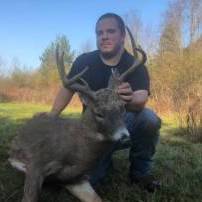-
Similar Content
-
By mike rossi
http://www.portal.state.pa.us/portal/server.pt?open=512&objID=12775&PageID=648010&mode=2&contentid=http://pubcontent.state.pa.us/publishedcontent/publish/marketingsites/game_commission/content/resources/newsreleases/newsrelease/articles/release__041_14.html
-
By mike rossi
Yup, I suppose this is another left-wing conspiracy. One in four deer, mostly yearling bucks, got CWD in a CWD area in Wisconsin... Off course, now that cant be true, tell me why its not, lol...
http://www.outdoorhub.com/news/cwd-spreads-wisconsin-counties/
-
By mike rossi
Note: Big rack, summer , green grass, abundant natural food, not a lactating female, eating out of a feeder which supplements natural food.
Also note the bucks rib cage is showing?
What is the "common sense" explanation for this? According to the Minnesota Deer hunters Association and many people on this board, CWD, EHD, and Lactic Acidosis are all some left wing conspiracy engineered by Cuomo, Obama, Nancy Pelosi, and Hillary Clinton - so we forget about Bengazzi ya know... . The MDHA even got their elected officials to force the DNR to feed deer, that just proves they know what they are talking about, them boys must got the facts straight and needed to set their DNR straight about them facts you know....
So what is the management prescription based on this bucks body condition? Do ya suppose they need to use a different kind of feed? Maybe the coyotes keep runnin em around so much the are a lossen the pounds... Maybe a year round yote season with a bounty?
-
By mike rossi
http://www2.dnr.cornell.edu/hdru/pubs/HDRU%2013_5%202012%20limits%20and%20priorities%20survey%0report.pdf
The Human Dimensions Research Unit at Cornell University published a report based on a two year study of state fish and wildlife agencies’ capacity to detect and respond to fish and wildlife disease threats. The report was funded by the Multistate Conservation Grant Program administered by the Association of Fish & Wildlife Agencies, and sponsored by the U.S. Fish and Wildlife Service. The authors of the report developed four steps to increase the capacity of state fish and wildlife agencies for detecting pathogens and improving fish and wildlife health programs: strengthening interagency relationships, securing resources necessary for program administration, developing communication and decision-making processes, and cultivating and maintaining public trust in state fish and wildlife agencies. Application of these steps will address factors such as inadequate funding, staffing, and public support that limit state agencies’ efforts on disease management tactics.
For more information about this research, please contact Bill Siemer at Cornell University (607-255-282 or [email protected]).
Sources: Human Dimensions Research Unit at Cornell University (June 2013).
-
By HuntingNY
Action Taken to Protect New York’s Deer Population in
Response to Pennsylvania Discovery
The New York State Department of Environmental Conservation (DEC) issued an emergency rulemaking that revises the state’s Chronic Wasting Disease (CWD) regulations in response to a confirmed case of CWD in Pennsylvania, DEC Commissioner Joe Martens announced today. Effective immediately, the revision prohibits importing certain parts of white-tailed deer or American elk taken in the state of Pennsylvania.
The Pennsylvania Department of Agriculture confirmed the first case of CWD in Pennsylvania on October 11 at a deer farm in New Oxford (Adams County), PA. CWD is a contagious neurological disease affecting deer, elk and moose. It causes a characteristic spongy degeneration of the brain in infected animals resulting in emaciation, abnormal behavior, loss of bodily functions and death. In response, DEC amended its CWD regulations to prohibit importing the following parts of deer or elk taken in Pennsylvania: brain, eyes, spinal cord, tonsils, intestinal tract, spleen or retropharyngeal lymph nodes.
“Hunters who take a deer or elk in Pennsylvania must now butcher the animal and remove the prohibited parts before entering New York State,” said DEC Commissioner Martens. “This action is necessary to protect New York’s populations of deer and moose. Most successful hunters already opt to butcher a deer and put the meat in a cooler before traveling back to New York.”
DEC’s ongoing extensive surveillance program, initiated in 2002, first confirmed CWD in New York State in 2005 and has not discovered any additional cases of CWD since that time. DEC recently revised its surveillance plan and efforts this year will concentrate on collecting tissues at taxidermists as well as deer processors.
It is not known exactly how CWD is transmitted. The infectious agent, a prion, may be passed from animal to animal through feces, urine or saliva. The minimal incubation period between infection and development of clinical disease appears to be about 16 months. The maximum incubation period is unknown, as is the point at which shedding of the CWD agent begins during the prolonged course of infection.
The movement of infected material is believed to be one of primary routes of transmission. This amendment to the CWD regulations prohibits importing those parts of a deer where the disease is most likely to be found. DEC advises hunters not to consume the meat of any animal that acts abnormal and to exercise precautions when butchering animals, such as using rubber or latex gloves. Also, DEC urges hunters to dispose of deer parts that will not be consumed in a municipal landfill.
Additional information about CWD can be found on DEC’s website at: http://www.dec.ny.gov/animals/7507.html and http://www.dec.ny.gov/animals/33220.html. Information is also available on the Chronic Wasting Disease Alliance's website at http://www.cwd-info.org/.
This post has been promoted to an article
-
-
Recently Browsing 0 members
No registered users viewing this page.






Recommended Posts
Join the conversation
You can post now and register later. If you have an account, sign in now to post with your account.